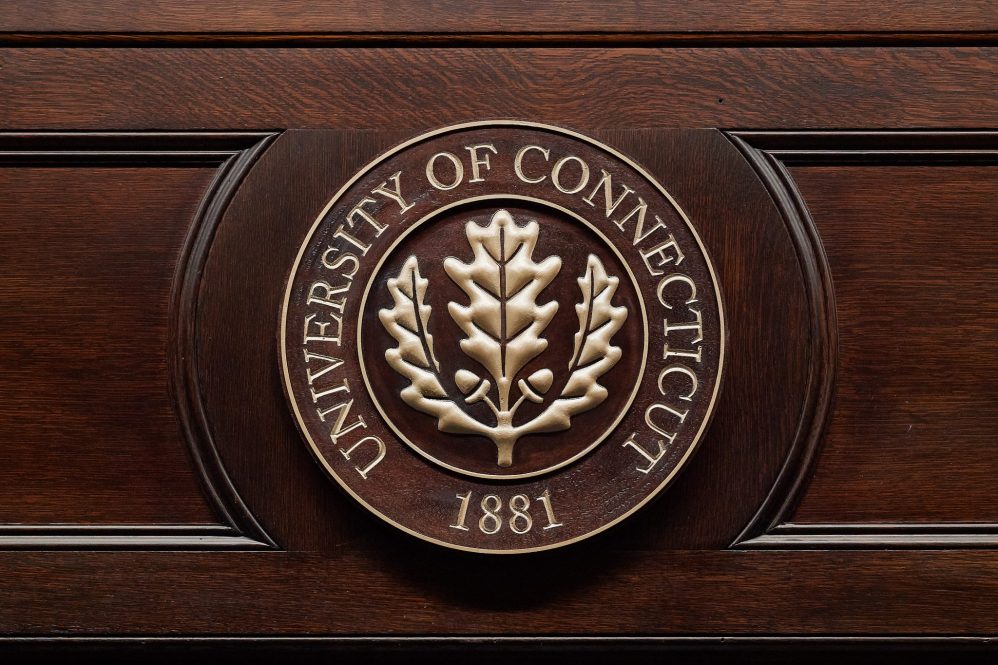UConn is releasing two reports detailing its response to reports of criminal activity, sexual violence, serious on-campus injuries, and other issues it monitors to ensure the safety of its campus communities.
The first, the Clery Annual Security and Fire Safety Report, is required from all U.S. universities that receive federal financial aid funds. It includes data about certain crimes identified by the Clery Act, including violations of the Violence Against Women Act; arrests and disciplinary referrals for drug and alcohol violations; and hate crimes reported on property that UConn owns or controls, and on public property within or immediately adjacent to campus.
It also includes a comprehensive overview of safety policies and prevention programs available to UConn’s campus communities. It is compiled by the UConn Division of University Safety.
The second report, compiled by UConn’s Office of Institutional Equity (OIE), is a state-mandated annual overview in which all Connecticut colleges and universities outline their policies and data on sexual assault, stalking, and intimate partner violence.
It captures a wider range of data in those categories than the Clery report because the data collected is not limited to incidents reported to have occurred on UConn property, and because it includes incidents reported even in the absence of a UConn connection.
Some categories listed in the Clery and OIE reports might appear to capture data about the same kinds of crimes and incidents, including some regarding sexual assault and related crimes.
However, the numbers will differ between the two reports because of the differences in how the incidents are defined, and the locations for which incidents must be captured.
In addition, some categories listed in the Clery reports and federally required Uniform Crime Reports (UCR) – from which crime rates are calculated – might appear to reflect the same kinds of crimes and incidents. However, the Clery and UCR numbers will also differ because they use different metrics on the populations and places for what is included in each report’s calculations.
Importantly, some figures involving sexual assault and related crimes may differ because the University prioritizes the wishes of the complainant in whether that person wants an investigation to be pursued. That helps them regain a sense of agency over their circumstances and is part of the process to help them make the journey to survivor.
The Clery report also includes an appendix with additional data required under Connecticut Public Act 21-184, which directs colleges and universities to report accidents on their campuses that result in serious injuries or deaths.
It is similar to the proposed federal COREY Act (College Operational Reporting of Emergencies Involving Teens and Young Adults), named for Corey Hausman, a Connecticut native who died of a head injury shortly after a skateboarding accident on his campus as a first-year student at the University of Colorado.
—
2024 Clery Annual Security and Fire Safety Report
UConn is posting the report for calendar year 2024 on its website and distributing the link electronically in compliance with federal and state law, and in the interest of informing all enrolled students, faculty, and staff on this important subject.
The Clery data includes reports from complainants made directly to UConn Police, along with information that comes to the attention of campus officials beyond law enforcement.
Those officials, known as “campus security authorities,” comprise more than 1,200 people who regularly interact with students in their roles as resident assistants, coaches, faculty advisers, and other on-campus authorities.
The university has significantly increased training for those officials so that they better understand what they are required to report and the proper way to do so. In the case of sexual violence crimes, UConn’s Clery numbers reflect a large amount of input from campus security authorities, along with significant outreach services university-wide to encourage reporting of this traditionally underreported crime.
Of the eight sexual assaults reported at Storrs in calendar year 2024 – the same number as in 2023 – police received two reports directly from individuals. The rest were reported by campus security authorities, including Residential Life and Student Affairs, to be included in the Clery report.
UConn takes an expansive view on what is included in the data by counting all sexual assault reports received in a given year, regardless of the level of detail known to the university; regardless of when the assault is reported to have occurred; and even when the report comes from a third party in the absence of a complainant.
This is an important part of UConn’s commitment to creating and maintaining a campus free from all forms of sexual harassment, sexual violence, relationship violence, and stalking.
Under a University policy, nearly all UConn employees are “responsible employees” to report sexual assault. Because that policy is specific to UConn and other institutions might take different approaches, comparisons are difficult to make against other universities whose policies are not as robust and whose reporting requirements are not as stringent.
The University provides information online for all individuals impacted by sexual assault to receive support and file reports, including through its website on sexual violence, relationship violence, and stalking awareness.
It also operates the UConn InForm site (inform.uconn.edu) to simplify and streamline reporting processes, offering an avenue through which students, faculty, staff and others can more easily locate and use the University’s many resources to report concerns and find support.
University officials also promote awareness of UConn’s bystander intervention programs, which help increase awareness of sexual violence on campus and empower students to be effective, proactive bystanders.
One such program, Protect Our Pack, is presented to all incoming first-year and transfer students at the Storrs and regional campuses during fall orientation as students settle in for the new academic year.
In addition, UConn Police also offers many initiatives tackling difficult conversations about stalking, intimate partner violence, consent, and effective communications. The programs are offered throughout the year to students at all academic levels.
Burglary reports are the only category that increased significantly between 2023 and 2024. In 2023, UConn Police received 12 reports of burglaries; in 2024, it was 27 reports.
The large majority of the 2024 reports were attributable to one individual, and occurred when that now-former student entered unlocked dorm rooms and took items from desks and other areas in plain sight, police say.
Nonetheless, the spike in numbers is prompting renewed reminders to students to always lock their residence hall and apartment doors, never to leave the room unattended when the door is unlocked, and not to leave valuable items in plain sight while the door is unsecured.
They also are encouraged to keep a list of model and serial numbers of all electronics in case of theft, consider a dorm safe for high-value items like jewelry and cash, and not to put notes on their doors stating their whereabouts and when they will return.
Faculty, staff, and students also are cautioned not to prop doors open that typically would be locked, or to unlock doors for strangers or let them enter behind you.
Under a state law that went into effect in 2021, UConn’s Clery report includes an appendix reporting serious accidental injuries or deaths that it can identify on its campuses for 2024.
Those incidents can include, but are not limited to, injuries or deaths that resulted from vehicle collisions, and in which pedestrians were hurt or killed while walking, jogging, bicycling, skateboarding, and similar activities.
The data must also include injuries and deaths from on-campus slips and/or falls such as tripping at ground level or falling from heights, including off bunk beds; alcohol or drug overdoses; choking or drowning; and other accidental incidents. The UConn Division of University Safety quantifies such incidents by reviewing reports from its police and fire/EMS records, Student Health & Wellness, and other sources.
UConn also proactively includes the information, which explains the University’s Bias Reporting system and reflects its numbers for the past three years.
Although none of the incidents met the threshold to be criminally prosecutable as a hate crime, UConn encourages members of its community to report incidents they believe exhibit bias based on race, ethnicity, ancestry, religion, national origin, sexual orientation, gender identity or expression, age, a past or present history of mental disorders, or physical, mental, and intellectual disabilities.
By encouraging members of the community to report these incidents under the bias protocol, the University can better provide support to people and groups who are affected, and to determine if those who exhibited the behavior – if they can be identified – violated the Student Code of Conduct.
2024 UConn OIE Report Pursuant to State Statute Section 10a-55m
In addition to the annual federally mandated Clery report, UConn also submits a yearly report to the General Assembly specifically on sexual violence policies and data.
Figures in this report exceed those in the Clery data because it captures all incidents disclosed to UConn, regardless of on or off-campus location or the year in which they are reported to have occurred.
It also includes information on prevention, awareness, and risk reduction programs and campaigns provided in the community throughout the year.
The 2024 OIE report indicates that OIE received 81 reports of sexual assault, of which 64 were reported to have occurred during 2024. The University’s definition of sexual assault is broad and can include incidents such as unwanted touching (sexual contact) along with more physically invasive offenses categorized in criminal law.
The sexual assault disclosure numbers also include reports of incidents from many years ago, including childhood abuse – all of which helps the university provide appropriate, compassionate, and trauma-informed services to students and employees if and whenever they choose to share their experience with the University.
Among the 81 reports of sexual assault logged in the newest report, 29 of the respondents were identified as being connected to UConn; seven of the reports came in anonymously or confidentially; and in seven cases, the complainant chose to participate in a University investigation.
Those who report an incident can request a University investigation at a later time should they wish, not only at the time they make a report.
The University takes steps to follow the wishes of the complainant whenever possible and does not investigate unless that individual wants the University to do so. Only in limited circumstances will the University proceed with an investigation against a complainant’s wishes.
Factors considered within this determination include the age of the complainant, whether there is evidence of a pattern of misconduct, the severity of the misconduct, and whether there is a safety risk to the complainant or the campus community.
In matters where an investigation does not occur, the University may still take responsive or preventative actions, such as meetings with the alleged respondent and/or additional training and prevention work with impacted communities.
UConn’s OIE report for 2024 also includes 37 reported incidents of stalking, of which 36 were reported to have occurred in 2024. In 19 of the stalking cases, the respondent was identified as being connected to UConn.
One complainant chose to participate in a university investigation at the time of making the report, but they all retain the right to request an investigation later if they wish.
A total of 72 cases of intimate partner violence (IPV) were reported, including 63 reported to have occurred in 2024. In 20 of the intimate partner violence cases, the respondent was identified as being connected to UConn; and in one of those cases, the complainant chose to participate in a University investigation.
As with other categories, those who reported intimate partner violence but chose not to participate in a University investigation can still request one later if they wish.
Pursuant to state law, UConn conducted a sexual misconduct climate assessment in 2024 in which students were asked their knowledge of key campus policies and UConn’s prevention and response efforts relevant to sexual and interpersonal violence.
The survey included questions about the participants’ experiences of sexual and interpersonal violence in the past 12 months, whether they reported the incident, and their experiences during the reporting process. It is being provided to the Connecticut General Assembly along with the OIE report.
In addition to providing data, the OIE report outlined several hundred awareness and prevention programs and campaigns during the year. They include the “Protect Our Pack” bystander intervention training provided at new student orientation; UConn’s Violence Against Women Prevention Program (VAWPP) Consent 201 courses; the widespread training provided to employees; and many others.
In addition to Storrs-specific brochures and programs, the University provides programs and publications tailored to the regional campus communities and UConn Health.



